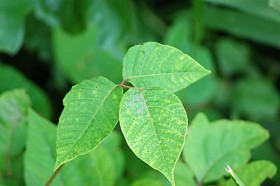 It is true. We have rash of Poison Ivy growing in some places at Crossroads at Big Creek. Visitors to Crossroads often ask whether the lush and healthy looking plants are Poison Ivy or Poison Oak. I suppose when using common names, “folk” can call anything what they want , but our native (it really is a native) plant really is Poison Ivy. Whatever one calls it, it’s prudent to recognize the characteristic “leaflets three.” The problem is, the characteristic appearance is not all that characteristic.
It is true. We have rash of Poison Ivy growing in some places at Crossroads at Big Creek. Visitors to Crossroads often ask whether the lush and healthy looking plants are Poison Ivy or Poison Oak. I suppose when using common names, “folk” can call anything what they want , but our native (it really is a native) plant really is Poison Ivy. Whatever one calls it, it’s prudent to recognize the characteristic “leaflets three.” The problem is, the characteristic appearance is not all that characteristic.
The plant grows in different forms in different part of the county. In the southern states and as far north as Illinois, Poison ivy can be a tree-climbing vine with pointy, jagged leaves. Other places, it is a woody shrub with rounded leaves. In the Great Lakes region, poison ivy tends to be knee-high, but one can’t count on that.
Botanist once believed that there were different species growing in different habitats. Logical, but wrong. Researchers, presumably wearing gloves, took cuttings from the same plant and planted them a variety of habitats. The plants grew in significantly different forms, depending on the growing conditions of the areas in which they were planted.
In cool moist forests, shiny pointed leaves develop. In sunny areas, rounded, lobed “oaky”looking leaves grow. Actually it’s not all that odd to find different shaped leaves growing on the same plant if side is in shade and the other side gets direct sun.
In Door County, in almost any disturbed area–along trails and roads, on beaches and dunes, and often, under wires (where birds like to perch,) Poison Ivy grows very well, so becoming aware of Poison Ivy is its various guises is a very good idea. Maybe it would be helpful to sketch the plants during one of our family programs.

